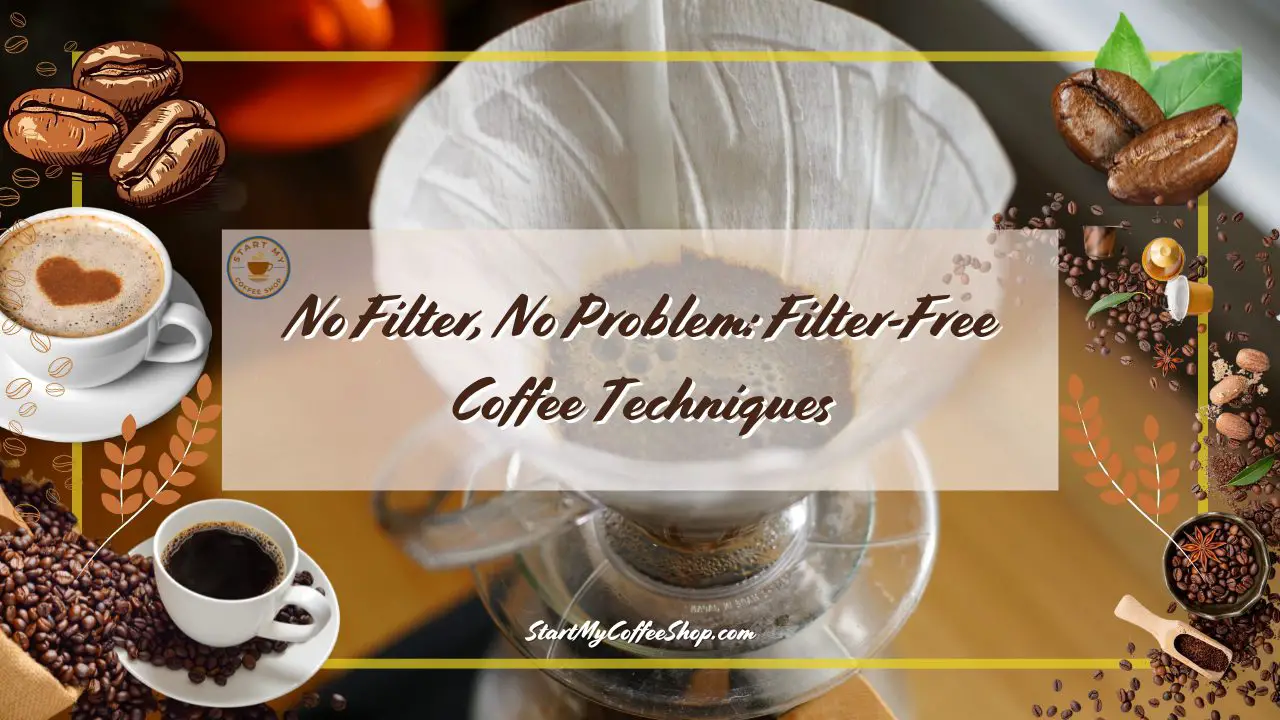A properly made cup of coffee is something to relish for coffee connoisseurs. While conventional coffee filters are frequently used to produce a smooth, sediment-free brew, you can occasionally find yourself without one. Don’t worry! If you don’t have a regular filter, there are other ways to filter your coffee.
To filter coffee without a filter, you should set a fine sieve or cheesecloth over a container. Carefully pour the brewed coffee through, allowing the liquid to pass through while trapping the grounds. Patience will reward you with a cleaner brew.
The Importance of Filtering Coffee

Filtering coffee is an important but often forgotten step in the coffee brewing process that has a big impact on the flavor and quality of your cup. Using filters is the traditional approach to remove undesirable coffee grounds and oils, giving a balanced and tasty cup, whether you like a delicate pour-over, a powerful French press, or any other brewing method. Paper, metal mesh, and cloth filters effectively catch coffee grounds and tiny particles, ensuring your coffee is free of undesired grit and sediment.
The function of filters extends beyond simply producing an aesthetically pleasing cup of coffee. They are essential in improving the overall taste and texture. Paper filters, for example, absorb coffee oils, lowering bitterness and acidity and resulting in a smoother, less astringent brew. Metal mesh filters, which are typically used in French press brewing, allow more oils to flow through, resulting in a richer and fuller-bodied coffee. Cloth filters, on the other hand, provide a balance between paper and metal filters, producing a clean cup while maintaining some of the natural oils and tastes of the coffee.
However, situations may develop in which you are unable to use these traditional filters. Maybe you’re camping in the woods or staying in a cabin with minimal supplies. In such cases, it may be tempting to skip the filtering procedure, but doing so can result in a less-than-pleasant coffee experience. Your coffee may become mixed with undesired grounds if not properly filtered, resulting in a gritty texture and excessive bitterness. These unpleasant traits can dominate the coffee beans’ delicate flavors, making them less pleasurable.
Fortunately, there are alternate techniques for filtering coffee that do not require a regular filter, allowing you to preserve the quality and taste you enjoy even when you lack the necessary instruments. You can still make a wonderful and sediment-free cup of coffee by studying and mastering these methods. One typical method is to use a fine sieve or cheesecloth as a makeshift filter. A fine sieve with a small enough mesh size can catch coffee grinds while allowing liquid to pass through. Similarly, cheesecloth with a tight weave can keep grinds out of the coffee.
When using a fine sieve or cheesecloth, patience and precision are essential. Pour the brewed coffee carefully through the sieve or cheesecloth, allowing the liquid to run through while capturing the grounds. Pouring too quickly may result in overflow and grounds passing through the sieve or cheesecloth, eventually ending up in your cup. Allow the coffee to naturally filter through, resulting in a cleaner and smoother brew.
Read more about: Coffee-Themed Serenity: A Blueprint for Coffee Shop Interiors
Choosing the Right Equipment
Filtering coffee without a filter involves some simple equipment that is generally available in most kitchens or can be obtained for a minimal cost. A fine sieve and cheesecloth, both of which are effective substitutes for regular coffee filters, are the two main choices. These tools make it easy to separate the coffee grounds from the liquid, resulting in a smoother, more refined cup of coffee.
The fine sieve is a useful culinary item made up of a metal or nylon mesh bowl with a handle. When filtering coffee with a fine sieve, ensure sure the mesh size is large enough to capture the coffee grounds while allowing the liquid to pass through. This means that the mesh should be fine enough to prevent large particles from escaping but not so fine that it impedes coffee flow. A medium-sized mesh sieve works well for this, finding the appropriate mix between filtering efficiency and ease of use.
Similarly, cheesecloth is a fantastic choice for filtering coffee without a filter. Cheesecloth is a loosely woven cotton fabric that traps coffee grinds while allowing liquid to pass through. When selecting cheesecloth, use one with a tight weave to capture even the finest coffee particles. It’s best to use a second layer of cheesecloth to improve filtration and prevent any unintentional grinds from escaping into the coffee.
Before beginning the filtering process, make sure your sieve or cheesecloth is clean and clear of debris or residues. Rinse it thoroughly with water to remove any potential impurities that may have an impact on the flavor of your coffee.
Place the fine sieve or cheesecloth over a clean container or coffee pot once it is ready. A vessel with a spout or pouring lip makes the filtering process easier to manage by allowing for a regulated and steady pour.
Pour the brewed coffee through the fine sieve or onto the cheesecloth with care. The coffee grounds will be trapped as the liquid goes through the sieve’s mesh or the tight weave of the cheesecloth, preventing them from reaching the final cup. Pouring the coffee carefully and steadily is critical to avoid overflow and ensure the coffee is uniformly filtered. A hurried or hurried pour may result in grounds going through the sieve or cheesecloth, producing a gritty and unsatisfactory coffee experience.
Preparing Your Coffee for Filtering
It is critical to have a fresh batch of brewed coffee on hand before beginning the coffee filtering procedure. Begin by making your coffee using your chosen method, whether it’s a French press, pour-over, percolator, or any other way you enjoy. Each brewing method imparts a distinct flavor character, so select the one that best suits your taste preferences.
Steep coarsely ground coffee in hot water, then press the plunger to separate the grounds from the liquid, for those who enjoy the full-bodied richness of French press coffee. Pour hot water slowly over the coffee grounds in a paper or metal mesh filter, allowing the brewed coffee to trickle into the carafe below. Percolators take a different strategy, passing hot water through the coffee grinds to reach the required strength.
Allow your coffee to rest for a few moments once it has been brewed to perfection. This little resting interval is necessary because it allows any remaining coffee grounds to settle to the bottom of the brewing vessel. The flavors of the coffee will combine during this period, resulting in a more harmonic and well-rounded taste.
Allowing the coffee to rest is also important for aiding the subsequent filtering procedure. The filtration process gets more efficient and effective as the grounds settle. This little wait minimizes the amount of coffee particles suspended in the liquid, making it easier to separate the coffee from the grounds afterward.
The resting period is an essential aspect of the brewing process for several brewing systems, like as the French press. Only after the specified steeping time has passed is the plunger gently pulled down, allowing the coffee grounds to be thoroughly removed before filtering begins.
Allowing your freshly brewed coffee to rest will result in a smoother and more flavorful cup. This extra step improves the entire coffee experience by increasing the aroma and taste while minimizing any potential bitterness or grittiness caused by insufficient filtering.
Using a Fine Sieve

It’s time to start the coffee filtering procedure after you’ve prepared your fine sieve or cheesecloth. Locate a clean container or coffee pot that can hold the amount of coffee you brewed. Using a spout-equipped vessel makes pouring considerably easier and more controlled, eliminating the chance of spills and assuring a smooth filtering experience.
Place the fine sieve securely over the container, making sure it rests firmly and evenly to keep coffee grinds from escaping around the sides. If you used cheesecloth, carefully lay it over the container, making sure it completely covers the opening and remains taut.
The most important step is to carefully pour the freshly brewed coffee through the fine sieve or onto the cheesecloth. The coffee grounds will be trapped when the liquid passes through the mesh or tight weave of the cheesecloth, keeping them from mingling into the filtered coffee.
Pour the coffee gently and steadily for the greatest results. A regulated pour reduces the likelihood of spillage and ensures that the coffee flows uniformly through the sieve or cheesecloth. If you rush through this step, coffee grounds will circumvent the filtering procedure and end up in your cup. So, patience is essential if you want a cleaner, grit-free brew.
Take a moment to study the filtering process as you pour. The flow velocity of the coffee may fluctuate as it flows through the sieve or cheesecloth. If you find the liquid accumulating above the mesh or fabric of the sieve, gently mix the coffee in the sieve or adjust the cheesecloth to create air passages. This will help the filtration process by allowing the liquid to pass more easily.
Remember that obtaining a sediment-free cup of coffee without a filter may take somewhat longer than using standard filters. However, the effort is rewarded with a smoother and more pleasurable coffee experience. If you practice patience during the filtering process, you will be rewarded with a refined and delicious cup of coffee.
Take time to appreciate your filtered brew once it has passed through the fine sieve or cheesecloth. You’ll notice a distinct difference between the filtered coffee and any residual coffee grounds. Fill your favorite mug or cup halfway with filtered coffee, ready to be savored and appreciated to the last drop.
Read more about: Coffeepreneurship: Developing a Unique Identity for Your Coffee Brand
Utilizing Cheesecloth for Filtering
Don’t worry if you don’t have a fine sieve. Cheesecloth can be a dependable alternative for filtering coffee. To use cheesecloth, just wrap it over a clean container or coffee pot, making careful to completely cover the opening. Hold the cloth in place with your hands for stability, or use a rubber band or string to fasten it if necessary.
Pour the newly made coffee onto the cheesecloth while it is still in place. The cheesecloth’s tight weave effectively retains the coffee grounds while allowing the liquid to pass through, resulting in filtered and grit-free coffee.
Maintain a firm hand while pouring to avoid unintentional spills. Maintaining control over the pour ensures that the coffee runs smoothly through the cheesecloth, leaving the grounds behind. To ensure thorough filtering, be patient and take your time during this process.
The Art of Patience
Filtering coffee without a filter requires some patience on the part of the coffee connoisseur. Using a fine sieve or cheesecloth, as opposed to standard filters, takes a little longer. The end product, though, is well worth the wait. Allow the coffee to pass through the sieve or cheesecloth at its rate, resisting the need to speed it up.
The flow rate may slow down during this natural filtration, which is completely normal. Rather than feeling frustrated, gently whisk the coffee in the sieve or make minor modifications to the cheesecloth. These basic activities generate air channels, which aid in the filtration process and allow the liquid to travel more smoothly.
Remember that the key to achievement is to be patient during the screening process. Believe that the coffee will ultimately pass through the fine sieve or cheesecloth, leaving the undesirable grounds behind.
Frequently Asked Questions
How can I filter coffee if I don’t have a filter?
You may filter coffee without a filter by using a fine sieve or cheesecloth. Pour the brewed coffee through the sieve, allowing the liquid to pass through while trapping the ground.
Is it possible to change the flavor of my coffee by using a fine sieve or cheesecloth?
The flavor of your coffee should be unaffected by filtering it through a fine sieve or cheesecloth. It may, however, offer a somewhat different mouthfeel than normal filters.
Is it time-consuming to filter coffee without a filter?
Filtering coffee via a fine sieve or cheesecloth may take somewhat longer than using standard filters. It takes time for the coffee to gradually move through the mesh, resulting in a cleaner brew. The extra work is well worth it if you want a smoother cup of coffee.
To learn more on how to start your own coffee shop, check out my startup documents here.
Disclaimer: The information provided by StartMyCoffeeShop.com (“The Site”) is for general informational purposes only. All information on the Site is provided in good faith. However, we make no representation or warranty of any kind, express or implied, regarding the accuracy, adequacy, validity, reliability, availability, or completeness of any information on the Site. Under no circumstance shall we have any liability to you for any loss or damage of any kind incurred as a result of the use of the Site or Reliance on any information provided on the Site. Your use of the Site and reliance on any information on the Site is solely at your own risk. This blog post is for educational purposes only and does not constitute legal advice. Please consult a legal expert to address your specific needs. Terms and Conditions. (https://startmycoffeeshop.com/terms-and-conditions/)

Hi! I’m Shawn Chun
My adventure in coffee began when I first launched my first coffee shop back in the early 2000s. I had to figure out so many things on my own and to make it worse within 2 years of opening two large corporate coffee chains moved in just blocks away from me!
As I saw smaller and even some larger coffee shops in the neighborhood slowly lose customers to these giant coffee chains and slowly close up shop, I knew that I had to start getting creative…or go out of business.
I (like you may be) knew the coffee industry well. I could make the best latte art around and the foam on my caps was the fluffiest you have ever seen. I even had the best state-of-the-art 2 group digital Nuova Simonelli machine money could buy. But I knew that these things alone would not be enough to lure customers away from the name brand established coffee shops.
Eventually, through lots of trial and error as well as perseverance and creativity I did find a way to not only survive but also thrive in the coffee/espresso industry even while those corporate coffee chains stayed put. During those years I learned to adapt and always faced new challenges. It was not always easy, however, in the end, I was the sole survivor independent coffee shop within a 10-mile radius of my location. Just two corporate coffee chains and I were left after that year. All told the corporate coffee chains took down over 15 small independent coffee shops and kiosks and I was the last one standing and thriving.
Along the years I meet others with the same passion for coffee and I quickly learned that it is not only “how good a barista is” that makes a coffee shop successful, but the business side of coffee as well.
Hence why I started this website you are on now. To provide the tools and resources for up and coming coffee shop owners to gain that vital insight and knowledge on how to start a coffee shop successfully.
Stick around, browse through my helpful blog and resources and enjoy your stay! With lots of LATTE LOVE!
Shawn






